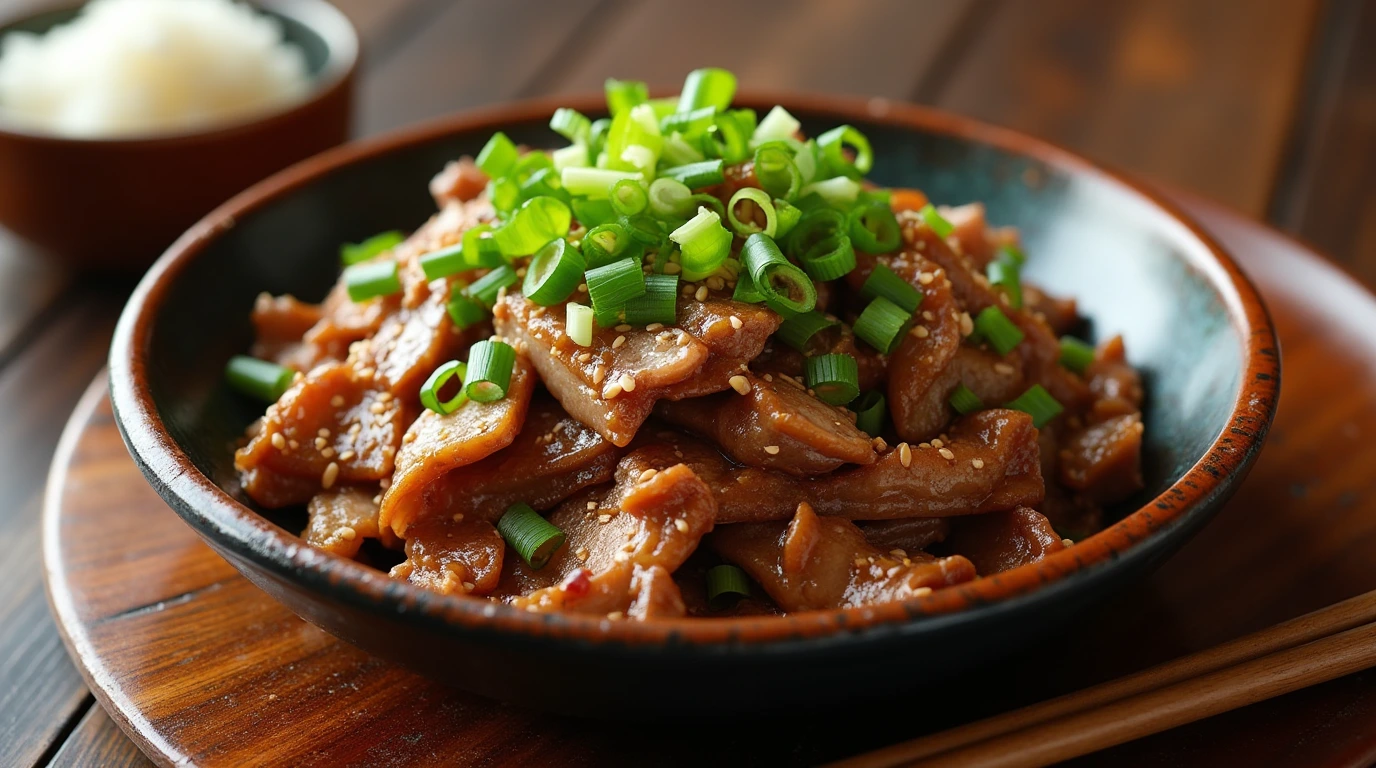Korean Beef: How To Make 3 Authentic Street Food Versions
Table of Contents
Are you tired of bland, uninspiring beef dishes that lack that authentic Korean punch? We’ve all been there – spending hours in the kitchen only to end up with something that tastes nothing like the mouthwatering Korean beef you’ve enjoyed at your favorite street food vendors.
This guide to making Korean Beef at home delivers three street food versions that are bursting with those bold, complex flavors you crave. After perfecting these recipes during my five years living in Seoul and learning from local street food vendors, I’m confident these dishes will transport your taste buds straight to the bustling markets of Korea.
In this comprehensive guide, you’ll discover expert tips for selecting the right cuts of beef, authentic marinades that deliver that signature Korean flavor profile, and foolproof cooking techniques that ensure tender, juicy results every time. Plus, I’ll walk you through common pitfalls and how to avoid them so your Korean Beef turns out perfect on the first try.
Why This Meat Recipe Works
- Uses affordable, easy-to-find cuts of beef that transform beautifully with Korean flavors
- Quick marinades that infuse maximum flavor in just 30 minutes (perfect for weeknight cooking)
- Versatile recipes that work for casual family dinners or impressive weekend gatherings
- Authentic techniques that deliver true Korean flavors without requiring specialty equipment
- Balance of sweet, savory, and spicy notes that make Korean Beef irresistible
- Recipes tested and perfected by home cooks to ensure reliable results every time
Choosing the Right Meat
Best Cuts for Korean Beef
For authentic Korean Beef dishes, selecting the right cut is crucial. Different street food styles call for specific cuts:
- Bulgogi: Thinly sliced ribeye or sirloin offers the perfect balance of tenderness and flavor. The marbling melts during cooking, creating that signature juicy texture.
- Galbi: Short ribs (specifically “flanken-cut” where the bones are cut across the ribs) deliver that authentic Korean BBQ experience with rich, meaty flavor.
- Japchae with Beef: Flank steak or skirt steak, sliced paper-thin against the grain, provides the ideal texture for this noodle dish.

Buying Tips
When shopping for Korean Beef dishes, look for:
- Bright cherry-red color indicating freshness
- Fine marbling throughout the meat for bulgogi
- Even thickness in short ribs for galbi
- Ask your butcher to slice the meat extra thin (1/8 inch) if you don’t have a sharp knife at home
Substitutions
If you can’t find the ideal cuts, consider these alternatives:
- Swap ribeye with sirloin or even ground beef for budget-friendly bulgogi
- Use boneless short ribs instead of bone-in for easier eating
- In a pinch, thinly sliced chuck roast can work for most Korean Beef recipes
Ingredients & Prep
Meat Prep Essentials
For all Korean Beef dishes, proper preparation is key:
- Partially freeze beef for 20-30 minutes before slicing for easier ultra-thin cutting
- Always slice against the grain to ensure tenderness
- For bulgogi, remove excess fat but leave some marbling for flavor
- For galbi, score the meat in a diamond pattern to help tenderize and allow marinade penetration
Marinades/Rubs
Classic Bulgogi Marinade:
- 1/4 cup soy sauce
- 2 tablespoons brown sugar
- 1 tablespoon sesame oil
- 2 tablespoons minced Asian pear (secret tenderizer!)
- 4 cloves minced garlic
- 1 tablespoon grated ginger
- 2 tablespoons green onions, chopped
- 1 tablespoon toasted sesame seeds
- 1/2 teaspoon black pepper
Marinate thinly sliced beef for 30 minutes minimum, up to 8 hours for deeper flavor.
Galbi Marinade:
- 1/2 cup soy sauce
- 1/4 cup brown sugar
- 2 tablespoons honey
- 1/4 cup rice wine or mirin
- 2 tablespoons sesame oil
- 6 cloves garlic, minced
- 1 small onion, grated
- 1 Asian pear, grated
- 1 tablespoon toasted sesame seeds
- 1 teaspoon black pepper
Marinate short ribs for at least 3 hours, preferably overnight.
Spicy Beef Marinade (for Japchae):
- 3 tablespoons soy sauce
- 1 tablespoon gochujang (Korean chili paste)
- 1 tablespoon brown sugar
- 1 tablespoon sesame oil
- 3 cloves garlic, minced
- 1 teaspoon ginger, grated
- 1 tablespoon green onions, chopped
- 1 teaspoon gochugaru (Korean chili flakes)
Marinate beef for 30 minutes while preparing other ingredients.
Pantry Staples
Essential ingredients for authentic Korean Beef:
- Gochujang (Korean chili paste) – adds complex heat and depth
- Gochugaru (Korean chili flakes) – provides bright, fruity heat
- Asian pear or kiwi – natural meat tenderizers
- Toasted sesame oil – for nutty, aromatic finish
- Rice wine or mirin – adds sweetness and helps tenderize
- Sesame seeds – for texture and visual appeal
Step-by-Step Cooking Instructions
Pre-Cooking Prep
- Remove marinated Korean Beef from refrigerator 30 minutes before cooking to reach room temperature
- Pat excess marinade gently with paper towels (don’t wipe completely dry)
- Prepare cooking surface (grill, pan, or wok) by heating to high heat
- Have all ingredients prepped and ready to go – Korean Beef cooks quickly!
Cooking Method: Bulgogi
- Heat a large cast-iron skillet or wok over high heat until smoking
- Add 1 tablespoon neutral oil (like vegetable or grapeseed)
- Add beef in a single layer, working in batches to avoid overcrowding
- Cook for 1-2 minutes per side until edges are caramelized but center remains juicy
- Remove immediately to prevent overcooking
- Optional: Add sliced onions, mushrooms, and carrots to the pan and stir-fry for 2-3 minutes
Cooking Method: Galbi
- Preheat grill to medium-high heat (around 400°F)
- Place short ribs on grill, leaving space between pieces
- Grill for 3-4 minutes per side for medium doneness
- Brush with remaining marinade during last minute of cooking
- Remove when internal temperature reaches 145°F for medium-rare
Cooking Method: Beef Japchae
- Heat wok or large skillet over high heat
- Add 1 tablespoon oil and quickly stir-fry marinated beef for 1-2 minutes until just cooked
- Remove beef and set aside
- In same pan, stir-fry vegetables (bell peppers, spinach, carrots, onions) for 2-3 minutes
- Add pre-cooked sweet potato noodles and beef back to pan
- Toss with sauce mixture (soy sauce, sesame oil, sugar) for 1 minute until well combined
Doneness Check
- Bulgogi: Beef should be just cooked through with caramelized edges
- Galbi: 145°F for medium-rare, 160°F for medium
- Beef Japchae: Beef should be tender with no pink remaining
Resting
- Let bulgogi rest for 1-2 minutes before serving
- Allow galbi to rest for 5 minutes to redistribute juices
- Japchae can be served immediately
Pro Tips for Perfect Korean Beef
Avoiding Tough/Dry Meat
- Never overcook Korean Beef – thin slices cook extremely quickly
- Cook in batches to maintain high heat and avoid steaming
- Use a meat thermometer for galbi to ensure perfect doneness
- Slice meat against the grain for maximum tenderness
- For bulgogi, use high heat and fast cooking to caramelize exterior while keeping interior juicy
Tool Recommendations
- Sharp chef’s knife or specialized meat slicer for ultra-thin cuts
- Cast-iron skillet or carbon steel wok for high-heat cooking
- Korean BBQ grill plate for authentic tabletop cooking experience
- Meat thermometer for perfectly cooked galbi
- Mandoline for uniform vegetable slices
Storage & Reheating
- Store leftover Korean Beef in airtight container in refrigerator for up to 3 days
- Freeze cooked bulgogi in its sauce for up to 2 months
- Reheat bulgogi in skillet with a splash of water to prevent drying out
- Japchae tastes excellent cold or at room temperature
- For best results, reheat galbi in 350°F oven for 10 minutes
Flavor Variations
Spicy Twist
- Add 1-2 tablespoons gochujang to any marinade for a spicy kick
- Incorporate thinly sliced fresh chilies for bright heat
- Serve with kimchi on the side for authentic spice experience
- Create a spicy dipping sauce with gochujang, vinegar, and sesame oil
Keto/Paleo
- Substitute brown sugar with monk fruit sweetener or erythritol
- Use coconut aminos instead of soy sauce
- Serve over cauliflower rice instead of traditional rice
- Increase sesame oil and reduce or eliminate sugar for keto-friendly version
Global Flavors
- Korean-Mexican Fusion: Use bulgogi in tacos with kimchi slaw
- Korean-Italian Twist: Serve thinly sliced bulgogi over pasta with gochujang cream sauce
- Korean-American Fusion: Korean Beef sliders with gochujang mayo and pickled vegetables
Serving Suggestions
Traditional Korean accompaniments for your Korean Beef:
- Steamed short-grain rice is the classic pairing
- Lettuce wraps (ssam) with perilla leaves and ssamjang sauce
- Banchan (side dishes) like kimchi, pickled radish, and spinach namul
- Cold noodles (naengmyeon) complement the rich flavors of galbi
Beverage pairings:
- Korean soju or makgeolli (rice wine) for authentic experience
- Light beer like Hite or Cass (Korean brands)
- Crisp white wines like Riesling or Gewürztraminer
- Barley tea (boricha) for non-alcoholic option
FAQs
Can I use frozen beef for Korean Beef recipes? Yes, but thaw completely first. Partially frozen beef actually slices more easily for bulgogi.
How can I make my Korean Beef more tender? Use Asian pear or kiwi in the marinade – they contain natural enzymes that tenderize meat. Don’t marinate longer than recommended or meat may become mushy.
Is Korean Beef spicy? Traditional bulgogi is not spicy, but you can add gochujang or gochugaru to increase heat level according to your preference.
Can I make Korean Beef in a slow cooker? Yes! Bulgogi works well in a slow cooker for 3-4 hours on low. Add vegetables during the last 30 minutes.
How do I fix too-salty Korean Beef? Add sliced onions, mushrooms, or carrots to absorb excess salt, or serve with plain rice to balance flavors.
Conclusion
Now that you’ve mastered these three authentic Korean Beef street food versions, your home cooking will never be the same. The combination of tender meat, bold flavors, and time-tested techniques brings the vibrant streets of Korea right to your dinner table.
Fire up your grill or heat your skillet and watch as these Korean Beef recipes become family favorites. The complex flavors and tender textures will have everyone asking for seconds!
Join thousands of home cooks who’ve discovered the joy of making restaurant-quality Korean Beef at home. And once you’ve perfected these recipes, check out our [Korean Fried Chicken Guide] for another authentic street food experience!
Did you like this recipe?
There are no reviews yet. Be the first one to write one.

